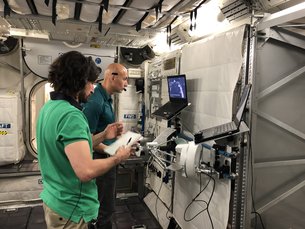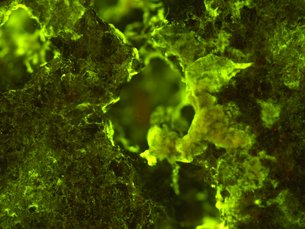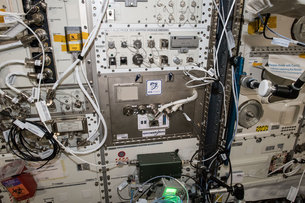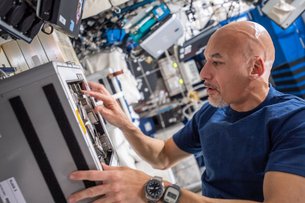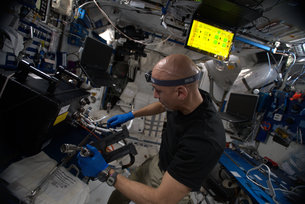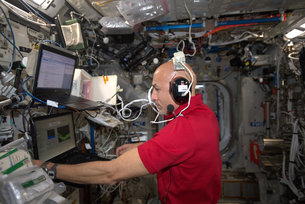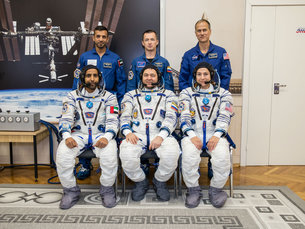21.07.2019
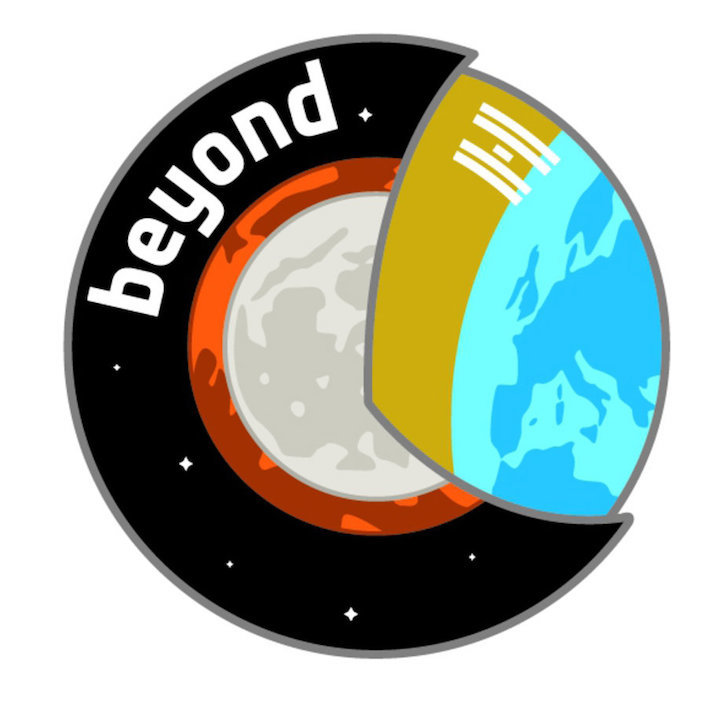
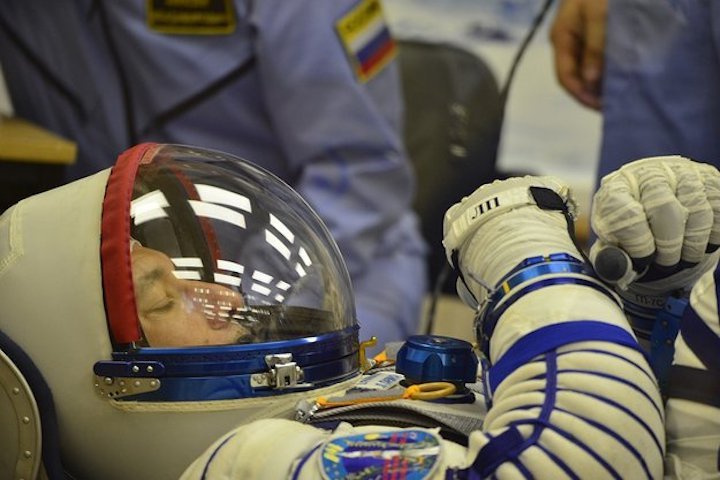
LUCA PARMITANO RETURNS TO THE INTERNATIONAL SPACE STATION
ESA astronaut Luca Parmitano has arrived at the International Space Station following a six-hour journey alongside crewmates NASA astronaut Andrew Morgan and Russian cosmonaut Alexander Skvortsov in the Russian Soyuz MS-13 spacecraft. Their arrival marks the start of Expedition 60 and Luca's second mission to the Space Station, known as 'Beyond'.
The trio was launched into space from the Baikonur Cosmodrome on 20 July 2019, 18:28 CEST and docked to the Station on 00:50:40 CEST on 21 July. After docking, the crew conducted thorough checks on the seals before being welcomed on board by NASA astronauts Christina Koch and Nick Hague, along with Russian cosmonaut and current Space Station commander Alexei Ovchinin when the Soyuz hatch opened at 03:04 CEST on 21 July.
Over the next six months, Luca will support more than 50 European experiments as well as 200 international experiments. These include investigations into how aspects of the human body are affected by microgravity and how astronauts could control robots remotely during lunar exploration.
When Alexei Ovchinin departs the Space Station at the end of Expedition 60, Luca will also take on the role of Space Station commander for Expedition 61. This is the third time a European astronaut and the first time an ESA astronaut from Italy has held this position. Luca will follow ESA astronauts Frank De Winne (2009) and Alexander Gerst (2018) when he takes command later this year.
Frank, who is now head of ESA’s astronaut centre in Cologne, Germany, says Luca’s appointment to the role of commander is a reflection of ESA’s standing among international space agencies: “People can rely on us, and they do rely on us,” he said. “Not only in terms of the hardware that we provide - to the Space Station and the service module for the Orion spacecraft, but also in the area of crew operations. I think that is a very good result of the investment that ESA Member States make.”
Bringing the Moon into focus
Launching 50 years after the first Apollo Moon landing, it is fitting that Luca will work on experiments designed to aid the future of space exploration.
These experiments include BioRock, which aims to help scientists understand whether microbes used to ‘biomine’ on Earth could also work on other planetary bodies, and to examine how communities of microorganisms grow on rocks in space.
Luca will also test and operate ESA’s Life Support Rack, designed to recycle carbon dioxide into breathable oxygen as part of ESA’s goal to enable astronauts to live independently from Earth on a sustainable basis. He will also operate an Earth-based rover from the International Space Station testing remote operations that could be applied on the Moon.
Results from these experiments will support ESA’s contribution to the lunar Gateway and the Heracles mission to the Moon in ongoing work with international partners.
“What has happened today is part of our journey forward to the Moon,” said ESA Director General Jan Wörner. “With our international partners, we are excited to be part of a new generation of space explorers, giving research opportunities and access to space to all of our Member States."
Stepping into space
Luca has also been preparing for spacewalks, working with teams on the ground to develop new procedures and tools to repair the Alpha Magnetic Spectrometer (AMS-02).
Installed outside the Space Station in 2011, AMS-02 is a particle physics detector collecting cosmic rays to help scientists understand dark matter and antimatter. It was initially only meant to operate in space for three years, but it was so successful in its mission that its life has been extended. To enable this to happen, three of its four cooling pumps require repair in a challenging spacewalk.
Going Beyond
Luca’s activities during the Beyond mission are part of ESA’s long-term vision to send the first Europeans beyond Earth orbit and establish Europe as a key partner in humankind’s exploration of the Solar System.
Working with international partners, ESA seeks to bring new knowledge, innovation and inspiration to all European citizens and increase accessibility for researchers through new Space Station facilities such as the International Commercial Experiments service (ICE Cubes) installed in the Columbus module in 2018.
“What we are learning in low Earth orbit will enable the next generation to go farther and keep exploring. For us to be able to go back to the Moon and towards Mars, we have to know how to survive and operate in those worlds. That is where the Space Station comes into play,” Luca says.
Latest updates from Luca
The first European press conference with Luca live from the Space Station is planned for 29 July at the Leonardo di Vinci National Museum of Science and Technology in Milan, Italy. This is open to European media and will be broadcast live.
Further updates from the Beyond mission will be published online at: http://lucaparmitano.esa.int/
Here you can also access the ESA Explores podcast, which will feature updates and interviews with astronaut experts throughout the mission.
Quelle: ESA
----
Update: 7.08.2019
.
TWO WEEKS OF SCIENCE AND BEYOND
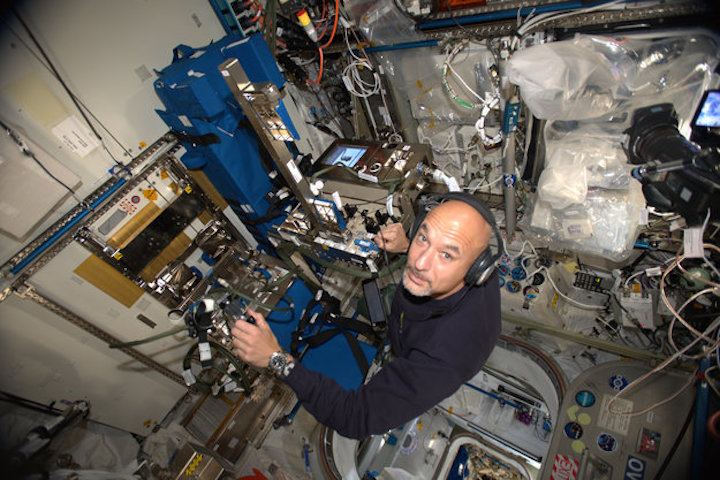
Luca performs GRIP experiment on the International Space Station
Over two weeks have flown by since ESA astronaut Luca Parmitano was launched to the International Space Station for his second six-month stay in orbit. His arrival, alongside NASA astronaut Andrew Morgan and Roscosmos Soyuz commander Alexander Skvortsov, boosted the Station’s population to six and the crew has been busy ever since – performing a wide range of science in space.
With the start of Luca’s Beyond mission on 21 July, and the capture of SpaceX’s Dragon 18 cargo vehicle on 27 July, came a host of new European experiments. We begin with a couple you may recognise from Alexander Gerst’s Horizons mission as Luca re-adapts to his orbital workplace.
Handling weightlessness
When you lift a cup of coffee, you are moving it against gravity. The amount of force you use to lift that cup or move any other object is something you learn as a child but, in the weightlessness of space, it is something astronauts must relearn.
The GRIP experiment studies how the central nervous system controls movements and the forces astronauts use to manipulate objects with their hands. After setting the experiment up in Europe’s Columbus laboratory on 28 July, both Luca and Andrew performed their first GRIP sessions last week.
Luca will take part in three GRIP sessions while on the International Space Station. He already performed two sessions on Earth and he will perform another three following his return. During each session, Luca will hold an object equipped with measuring instruments between his right thumb and index finger and carry out a variety of movements.
The results will help researchers understand potential hazards for astronauts as they move between different gravitational environments and improve the design of haptic interfaces used during deep space missions.
GRASP (Gravitational References for Sensimotor Performance) is another one you may remember from Alexander’s Horizons mission. Here researchers seek to better understand how the central nervous system integrates information from different senses, such as sight, sound and touch, to coordinate hand movements and determine what role gravity plays. Both Luca and Andrew also performed their first in-space GRASP sessions at the end of last week, wearing virtual reality headsets as they carried out a range of tasks.
The results of GRASP will be helpful in guiding astronauts during spacewalks and developing the most effective ways of controlling robots remotely from space. But they will also help us better treat disorders relating to vertigo, dizziness, balance and spatial orientation on Earth and could help surgeons and other professionals who need to tele-operate equipment.
First glimpse at new experiments
The first new experiment Luca set-up as part of his second mission was NutrISS. Developed by Kaiser Italia for the Italian space agency ASI and ESA, this experiment will periodically assess any changes in Luca’s body weight, fat mass, and fat-free mass during spaceflight, juxtapose this with his diet and better equip medical teams to provide advice for maintaining good health in orbit.
Luca will use an app called Everywear to record the results of each measurement session and log his nutritional intake for five consecutive days. Everywear is like the space version of MyFitnessPaland allows astronauts to track their intake by scanning barcodes on the food they eat. The information Luca enters into Everywear will be accessible to his medical team who will look at it in relation to his measurements and provide dietary recommendations.
As well as NutrISS, Luca also set-up Biorock by retrieving experiment containers from the Minus Eighty-Degree Laboratory Freezer for ISS (MELFI) and installing them in the small temperature-controlled Kubik incubators. The University of Edinburgh experiment will continue to run in Kubik, unleashing a microbe on a basalt rock and assessing the biofilm that forms over the rock as the organism grows. Observing the rock-microbe system in space will help researchers understand the potential for biomining on other planetary bodies like asteroids, where new resources could be unearthed.
Looking ahead
There is plenty planned for the crew in the weeks to come, but one highlight is the installation of Rubi (Reference mUltiscale Boiling Investigation). Developed and built by Airbus for ESA, Rubi aims to address the fundamentals of the boiling of fluids and is expected to be installed by Luca in the Columbus module this Friday 9 August.
We will communicate more about Rubi in the days to come. You can also follow this experiment on Twitter and stay tuned for the next snapshot of Space Station science.
Quelle: ESA
----
Update: 16.09.2019
.
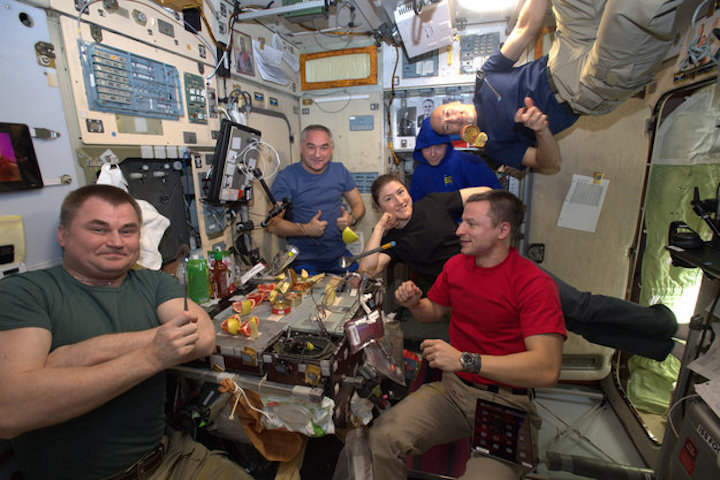
SPACE STATION SCIENCE: LEARNING FROM LUCA
There is plenty of science on the boil at the International Space Station – including an experiment literally designed to expand our knowledge of the boiling process.
Get a glimpse into the experiments ESA astronaut Luca Parmitano has been working on over the past two weeks in this fortnightly spotlight on Space Station science.
Easy as Astro Pi
The European Astro Pi Challenge is a school project run by ESA in collaboration with the Raspberry Pi Foundation and gives young people the opportunity to write code that runs on mini-computers on board the International Space Station. This year, Luca is the European Astro Pi challenge ambassador and on 12 September he launched this year’s challenge with a video outlining the details and calling for submissions.
Keeping it fluid
As mentioned in a previous Space Station science update, there is new research bubbling up in Europe’s Columbus laboratory. Luca installed the Multiscale Boiling experiment (affectionately known as Rubi) in the Fluid Science Laboratory last month. This is now in full swing and generated its first bubble under controlled conditions.
While the bubbles form, a temperature sensor measures bubble temperature while a high-speed camera records how the bubbles behave and an infrared camera tracks the temperature of the heated region. Scientists will observe and quantify the effect of external forces on the boiling process.
In the weightlessness of space, boiling takes place in slow motion and produces larger bubbles. This allows scientists to observe and measure effects that are too fast and too small on Earth. With this insight and more accurate calculations of the boiling process, industry can produce better and more compact products such as laptops on Earth.
Rubi will run more than 600 tests during its five-month stay on the Space Station.
Astronauts as test subjects
When it comes to a space mission, astronauts truly do give it their all – that includes participating in experiments where they are the guinea pig for space research. Of the more than 50 European experiments Luca is involved in, 12 are classed as human research.
Two of these are new experiments from the Italian space agency ASI: Acoustic Diagnostics and NutrISS. Recently Luca carried out his second in-space sessions of both.
NASA astronaut Andrew Morgan is also lending his ears to the Acoustic Diagnostics experiment, which aims to understand how life in microgravity and on the International Space Station impacts an astronaut’s hearing. In order to do this, the experiment monitors what are known as optoacoustic emissions (OAEs).
OAEs are caused by the motion of inner ear hairs in response to auditory stimulation. That means the measurement is passive. Astronauts put on headphones with a special inner-ear tip that simultaneously plays sound and measures their ears’ reactions.
In the next episode of ESA Explores, we will focus on the different sounds of life on Station. This includes a special snippet of the sounds Luca hears during the Acoustic Diagnostics experiment so make sure you tune in via your favourite podcast platform.
Looking ahead
With the next Soyuz launch scheduled for 25 September, it is not long before Luca and his crewmates will welcome three new arrivals to their orbital outpost.
Russian cosmonaut Oleg Skripochka, NASA astronaut Jessica Meir and United Arab Emirates (UAE) astronaut Hazza Al Mansouri will launch from the Baikonur Cosmodrome in Kazahkstan and are currently in quarantine in Star City, Russia as they prepare for the mission ahead.
Quelle: ESA

